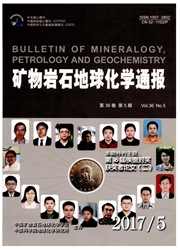

 中文摘要:
中文摘要:
为制备具有高效吸附、光催化性能,可磁分离回收催化剂的凹凸棒石-TiO2-磁颗粒纳米复合材料,本文研究了不同反应温度、不同量的氧化剂加量、不同的碱加入量对复合材料磁化率的影响,并利用透射电镜、X射线粉末衍射对制备的复合材料结构和微形貌进行了表征。实验结果表明,在70℃下,Fe^2+:OH^-:NO^3-质量比为1:0.6;0.056时,反应生成的产物再经500℃煅烧,获得的凹凸棒石-TiO2-磁性颗粒纳米复合材料的磁化率最高。高分辨透射电镜表征结果显示,经500℃煅烧获得的凹凸棒石-TiO2-磁性颗粒复合材料,其TiO2和磁性颗粒非常均匀地吸附在凹凸棒石表面。
 英文摘要:
英文摘要:
In order to prepare a nano-composite materials, which are composed of palygorskite-Ti(OH)4-magneticparticles, with high effective absorption, photocatalysis and recoverability of catalyst by magnetic separation, the influences on the susceptibility of the composite materials produced under different reaction temperatures, with different adding dosages of oxidizer and of alkali respectively have been studied in this paper. The texture and micro-morphology of the prepared composite materials have been characterized by using TEM, X-ray powder diffraction. Experimental results show that the nano-composite material, which is produced through process of mixing of palygorskite, Ti(OH)4, and magnetic particles at the Fe^2+ : OH^- : NO^3- ratio of 1 : 0.6 : 0. 056 at 70℃, and then burning at 500 ℃, has the highest magnetic susceptibility. The high resolution TEM analysis shows that the TiO2, and magnetic particles are adsorbed evenly on the surface of palygorskite in the composite material which has been burned at 500℃.
 同期刊论文项目
同期刊论文项目
 同项目期刊论文
同项目期刊论文
 期刊信息
期刊信息
